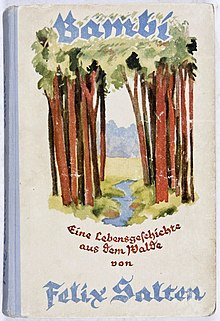Bibliography of writings by Chambers
Translations

- Bambi (1928): Bambi. Eine Lebensgeschichte aus dem Walde by Felix Salten. Published by Ullstein Verlag, Austria in 1923. Translated by Whittaker Chambers as Bambi, A Life in the Woods . Published by Simon & Schuster, New York in 1928.
- Complete list of translations 1928-1940
Books and plays
For the best known work written by Chambers, see separate entry Witness (memoir)
Contents
- Bibliography of writings by Chambers
- Translations
- Books and plays
- Online
- Collections
- Magazine or journal articles
- Collected magazine articles
- Other media
- Video on Chambers
- Photos
- Hiss–Chambers case
- Books on Hiss case (and Second Red Scare)
- Articles on Hiss case
- Film on Hiss case
- Articles or chapters on Chambers
- Chambers and Soviet espionage
- Novels that include characters based on Chambers
- References
- External links
- See also
- Chambers, Whittaker (1932). Can You Hear Their Voices?. International Pamphlets.
- Chambers, Whittaker (1952). Witness. Random House. ISBN 0-89526-571-0.
- Saints for Now. Ignatius Press. 1952. ISBN 0-89870-476-6. (includes a Commonweal article by Whittaker Chambers) [1]
- Chambers, Whittaker (1964). Cold Friday. Random House. ISBN 0-394-41969-3.
Online
- Chambers, Whittaker. "National Review [complete articles]". National Review . Retrieved 2012-03-18.
- Chambers, Whittaker (1986). "A Letter to My Children". Heritage Foundation. Retrieved 29 September 2020.
- Chambers, Whittaker (2008). "List of Translations by Whittaker Chambers". WhittakerChambers.org. Retrieved 2012-03-11.
Collections
- Chambers, Whittaker (1987). Buckley Jr., William F. (ed.). Odyssey of a Friend: Letters to William F. Buckley Jr. 1954-1961. Regnery Publishing, Inc. ISBN 0-89526-567-2.
- Chambers, Whittaker (1997). de Toledano, Ralph (ed.). Notes from the Underground: The Whittaker Chambers/Ralph de Toledano Letters, 1949-1960. Regnery Publishing, Inc. ISBN 0-89526-425-0.
- Chambers, Whittaker (1989). Teachout, Terry (ed.). Ghosts on the Roof: Selected Journalism of Whittaker Chambers, 1931-1959. Regnery Publishing, Inc. ISBN 0-89526-765-9.
- Chambers, Whittaker (2014). The Whittaker Chambers Reader: His Complete National Review Writings, 1957 to 1959. National Review.
Magazine or journal articles
New Masses
Time
Life
- 1947–1948:
- "The Middle Ages" (April 7, 1947)
- "Medieval Life" (May 26, 1947)
- "The Glory of Venice" (August 4, 1947)
- "The Age of Enlightenment" (September 15, 1947)
- "The Edwardians" (November 17, 1947)
- "Age of Exploration" (March 22, 1948)
- "The Protestant Revolution" (June 14, 1948)
- "The Devil Throughout History," (February 2, 1948)
- "Is Academic Freedom in Danger?" (June 22, 1953)
- "The End of a Dark Age Ushers in New Dangers" (April 30, 1956)
Commonweal
- "The Sanctity of St. Benedict" (September 19, 1952)
National Review
- "Big Sister Is Watching You" (December 27, 1957)
- "all National Review articles 1957–1959
Collected magazine articles
- Chambers, Whittaker. "Time articles by Whittaker Chambers". WhittakerChambers.org. Retrieved 11 December 2010.
- Chambers, Whittaker. "National Review articles by Whittaker Chambers". WhittakerChambers.org. Retrieved 28 June 2012.